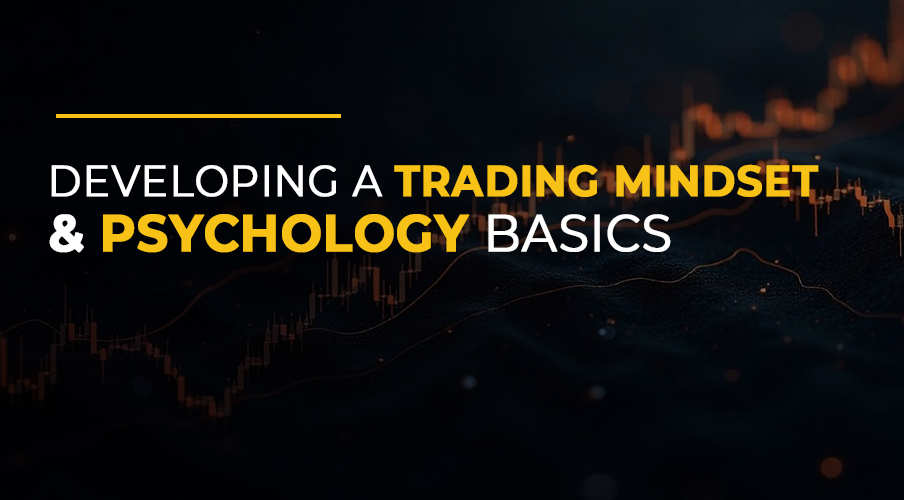FXCareers Blogs
 Go Back Home
Go Back Home

 04-07-2025
04-07-2025 5 minutes of Reading
5 minutes of Reading
Developing a Trading Mindset & Psychology Basics
1. Why Trading Psychology Matters
Even the best Forex Trading Strategies or Advanced Forex Trading Strategies from our 90‑hour Training Course in Currency Market can fail if your mind isn’t prepared. Emotions drive over‑trading, hesitation, revenge trading, and premature exits.
Example: In June 2025, many traders who held positions during a sudden USD rally closed winners too early out of fear, missing the full move—demonstrating how emotion erodes potential profit.
2. Key Psychological Concepts & Biases
Confirmation Bias
- What it means: You seek out information that confirms your existing view and ignore anything that contradicts it.
- Why it hurts: You’ll overrate setups you “like” and dismiss warning signs at your peril.
- Quick fix: Before every trade, write down 1–2 reasons why the setup might fail.
Loss Aversion
- What it means: Losses feel roughly twice as painful as equivalent gains feel pleasurable.
- Why it hurts: You may close winners too soon out of fear or let losing trades run, hoping they’ll turn around.
- Quick fix: Pre‑define your risk (e.g., 1–2% of equity) and stick to your stop‑loss without second‑guessing.
Overconfidence
- What it means: You overestimate your skill level or the accuracy of your analysis.
- Why it hurts: Leads to oversized positions and skipping your own trading rules.
- Quick fix: Cap your maximum position size and review your win/loss record objectively each week.
Recency Bias
- What it means: You give too much weight to the most recent events or trades.
- Why it hurts: You might chase last week’s winners or avoid instruments because of one bad trade.
- Quick fix: Base decisions on longer timeframes—review performance monthly or quarterly, not just your last few trades.
Mindfulness
- What it means: Staying fully present—observing your thoughts and emotions without immediately reacting.
- Why it hurts: Without it, you’ll react impulsively to every chart swing or P&L blip.
- Quick fix: Take a 2‑minute breathing break before each trading session to center yourself.
3. Building Emotional Discipline
- Pre‑Trade Routine
- Check your Trading Plan: instrument, timeframe, entry/exit, risk.
- Do a 2‑minute mindfulness exercise—focus on breath, observe any tension.
- During Trade
- Avoid “watching the P&L bar” obsessively.
- If you feel strong emotion (anxiety, greed), pause: step away for a moment.
- Post‑Trade Reflection
- Log not only the setup and outcome but also your emotions:
- “I felt anxious when price approached my stop.”
- “I was overconfident after three winners.”
- Log not only the setup and outcome but also your emotions:
4. Practical Techniques
- Journaling with Emotion Tags
- In your journal (e.g., spreadsheet), add a column for “Emotion” and rate from 1 (calm) to 5 (extreme).
- Checklist for Bias‑Checking
- Have I looked for evidence against this trade?
- Am I sizing this based on plan or on how “sure” I feel?
- Is last week’s performance coloring my judgment?
- Accountability Partner or Mentor
- Share your plan and trades with someone (could be a forum or our Expert Mentors at FXCareers to keep you honest.
5. Real‑World Example
A swing trader following an Advanced Financial Market Analysis module noticed a clear breakout on EUR/USD. Feeling overconfident from prior wins, she doubled her position size—against her plan. The market quickly reversed on an unexpected economic release, and she took a much larger loss than intended.
Lesson: Without emotional checks and strict adherence to risk management, even technical setups from Chart Analysis modules can lead to blow‑ups.
6. Self‑Assessment & Exercise
- Bias Spotting: Review three recent trades and identify any of the biases above.
- Pre‑Trade Mindfulness: Commit to a 2‑minute breathing exercise before your next five trades. Log how it affected your decision‑making.
- Emotion Journal: For the next week, tag every trade with an emotion rating. At week’s end, look for patterns.
7. Glossary of Educated Terms
- Confirmation Bias: Favoring information that confirms your beliefs.
- Loss Aversion: Discomfort from a loss outweighs pleasure from an equivalent gain.
- Overconfidence: Overestimating your skills or the accuracy of your information.
- Recency Bias: Over‑weighting recent data when making decisions.
- Mindfulness: Non‑judgmental awareness of one’s thoughts and feelings in the moment.
8. Next Steps & Enroll for Deeper Learning
Trading psychology is vital, but it’s just one pillar of a complete trader education. At FXCareers, our KHDA‑certified courses dive deep into:
- Market Fundamentals & Geopolitical Analysis
- Chart Analysis & Technical Indicators
- Advanced Forex Trading Strategies
- Comprehensive Risk Management
Best of all, you can choose online or offline modes, learn from Expert Mentors, and earn a recognized certification upon completion.
Ready to master trading psychology alongside strategy and tools?
Enroll now:
https://www.fxcareers.ae/courses
Equip yourself with both the mindset and methods for consistent trading success!

.png)

.png)
